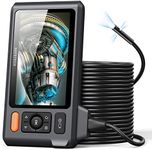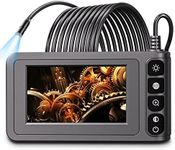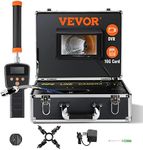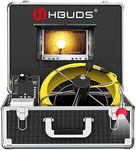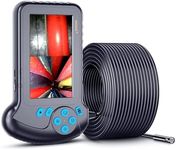Buying Guide for the Best Sewer Cameras
Choosing the right sewer camera is all about understanding your inspection needs and the environments you'll be working in. Sewer cameras, also known as pipe inspection cameras, help you see inside pipes and drains to diagnose blockages, damage, or other issues without digging or dismantling. To make the best choice, you should consider the types of pipes you'll be inspecting, the typical length and diameter of those pipes, and the conditions you expect to encounter (such as water, debris, or bends). By focusing on the key specifications, you can find a camera that makes your inspections easier, more accurate, and more efficient.Camera Head SizeThe camera head size refers to the diameter of the camera at the end of the cable. This is important because it determines which pipe sizes the camera can fit into. Smaller camera heads (around 15-23mm) are suitable for narrow pipes and household plumbing, while larger heads (30mm and above) are better for bigger sewer lines. If you mostly work with residential pipes, a smaller head is more versatile, but for municipal or industrial pipes, a larger, more robust head may be necessary.
Cable LengthCable length is the total distance the camera can travel inside a pipe. This is crucial for reaching blockages or inspecting long pipe runs. Shorter cables (10-30 meters) are ideal for home use or short pipe sections, while longer cables (30-60 meters or more) are needed for commercial or municipal work. Consider the typical length of the pipes you need to inspect and choose a cable that can comfortably reach the farthest point.
Camera ResolutionCamera resolution determines how clear and detailed the images or videos from the inspection will be. Higher resolution cameras provide sharper images, making it easier to spot small cracks or obstructions. Basic models may offer standard definition, which is fine for general blockages, while higher-end models offer high definition for detailed inspections. If you need to document findings or spot fine details, opt for higher resolution; for simple blockage checks, standard resolution may suffice.
LightingLighting refers to the built-in LEDs or lights around the camera head that illuminate the inside of the pipe. Good lighting is essential for clear visibility, especially in dark, dirty, or murky pipes. Some cameras have adjustable brightness, which helps in different conditions. If you expect to work in very dark or large pipes, look for a camera with strong, adjustable lighting. For smaller, cleaner pipes, basic lighting may be enough.
Monitor Type and SizeThe monitor is the screen where you view the live feed from the camera. Monitor size and type affect how easily you can see and interpret the images. Larger screens (7 inches or more) are easier to view, especially in bright outdoor conditions, while smaller screens are more portable. Some monitors are built into the carrying case, while others are separate. If you need to show findings to clients or work in teams, a larger, high-quality monitor is helpful; for solo, quick checks, a smaller screen may be sufficient.
Recording and StorageRecording and storage features allow you to save videos or images from your inspections for later review or sharing. Some cameras have built-in memory, while others use SD cards or USB drives. If you need to document inspections for reports or insurance, make sure your camera can record and store footage. For simple, real-time checks, this feature may be less important.
Waterproof and Durability RatingThe waterproof and durability rating tells you how well the camera and cable can withstand wet, dirty, or rough environments. Look for cameras with high waterproof ratings (like IP67 or IP68) if you expect to work in submerged or very wet pipes. Durability is also important if you’ll be pushing the camera through rough or corroded pipes. If your work is mostly in clean, dry pipes, you may not need the highest ratings, but for sewer and drain work, robust waterproofing is essential.
Flexibility and ManeuverabilityFlexibility and maneuverability refer to how easily the camera and cable can navigate bends, turns, and joints in the pipe. More flexible cables and smaller camera heads can get around tight corners, which is important in older or complex plumbing systems. If you often inspect pipes with many bends, prioritize flexibility; for straight, open pipes, this is less critical.

